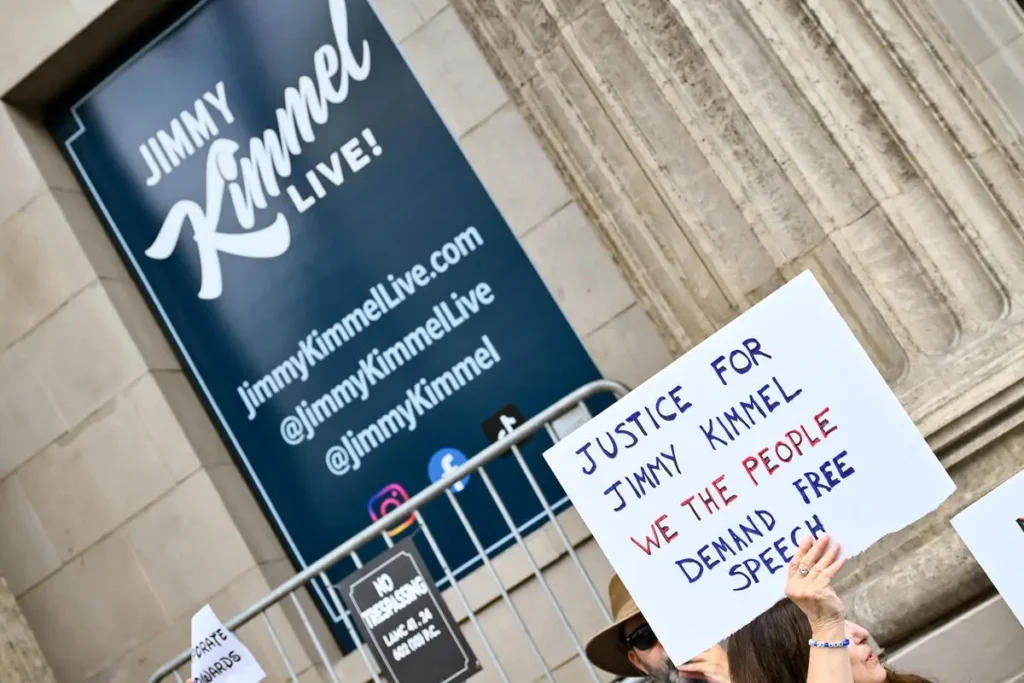After months of anticipation, Jimmy Kimmel Live! is returning to the air tonight, promising fresh monologues, celebrity interviews, and the irreverent blend of comedy and commentary that has kept it a staple of American late-night television for over two decades. Fans have long awaited the revival of its nightly rhythm, especially after interruptions caused by strikes, scheduling conflicts, or wider network disruptions. Yet despite the excitement, not everyone across the United States will have the opportunity to tune in.
More than 60 ABC affiliates owned by Sinclair Broadcast Group and Nexstar Media Group have announced they will continue to preempt the program in favor of alternative “news programming.” This means large swaths of viewers who rely on local ABC affiliates for late-night entertainment will instead find local news reports or syndicated replacements in the slot traditionally reserved for Jimmy Kimmel.
Why Kimmel Matters in Late-Night Television
Jimmy Kimmel has carved out a unique position among his peers in late-night. Unlike the often self-serious tones of news anchors or the chaotic unpredictability of internet commentary, Kimmel represents a middle ground—an entertainer who blends humor with social critique. His nightly show is both a place to laugh at absurdities in politics, sports, and celebrity culture, and a forum where serious issues are addressed with candor.
His role became especially pronounced during moments of cultural crisis. Kimmel has delivered emotional monologues on issues ranging from healthcare reform to gun violence, often departing from scripted comedy to share personal stories. These moments transformed Jimmy Kimmel Live! from just a late-night comedy show into a cultural platform. To deny access to such a voice, many critics argue, is to deny communities the chance to participate in a larger national conversation.
The Issue of Preemption
At the midst-center of the current controversy lies the decision by Sinclair and Nexstar—two of the largest operators of local television stations in the U.S.—to preempt Jimmy Kimmel Live! with their own programming. Officially, the affiliates have pointed to “news programming needs” and local content priorities as the rationale. In practice, however, the move reflects deeper structural and political tensions within American broadcast media.
Preemption in television is not new. Local affiliates have historically had the discretion to override network programming to broadcast events of local interest, such as severe weather coverage or breaking news. What is unusual here is the scale and consistency of the preemption. Instead of occasional interruptions, these affiliates have chosen to systematically replace Kimmel’s show with alternative offerings—effectively removing him from large portions of the nightly lineup.
Free Speech, Politics, and Perception
The decision has sparked public protest. Outside studios and affiliate offices, fans have held signs demanding “Justice for Jimmy Kimmel” and “We the People Demand Free Speech.” These slogans frame the issue not just as one of television scheduling, but of censorship and political silencing.
Jimmy Kimmel has been outspoken in his criticism of political figures, particularly conservatives, and has often used his platform to advocate for progressive policies. His sharp critiques of Donald Trump, his emotional pleas for healthcare reform, and his monologues on climate change have made him both a beloved figure on the left and a frequent target of criticism on the right.
By pulling his show from dozens of markets, affiliates risk being seen as engaging in politically motivated censorship rather than neutral programming choices. For viewers, especially those already skeptical of media conglomerates, the move reinforces anxieties about corporate control of information.
The Role of Sinclair and Nexstar
To understand the weight of this moment, it is important to consider the influence of Sinclair Broadcast Group and Nexstar Media Group. Together, these two corporations own or operate hundreds of local television stations across the United States, giving them immense power over what content reaches local audiences.
Sinclair, in particular, has faced criticism in the past for requiring its stations to air “must-run” segments with conservative editorial slants. Viral compilations have shown anchors across multiple local markets reading the same scripted commentary verbatim, raising concerns about centralized messaging masquerading as local news. Nexstar, while somewhat less notorious, also exerts substantial influence through ownership of major local stations.
Thus, when these groups collectively preempt a national late-night program, the act is not a minor scheduling decision—it is a deliberate editorial stance with national implications.
Viewers Left in the Dark
For fans, the frustration is both practical and symbolic. Practically, it means missing out on nightly entertainment they have come to rely on. Symbolically, it signals that their local station has chosen to withhold a cultural voice that many view as essential to late-night television.
In the age of streaming, some viewers will inevitably turn to platforms like Hulu or YouTube to catch up on Kimmel’s monologues and interviews. Yet for those who depend on broadcast television—often older demographics or those without high-speed internet—the absence is glaring. The preemption disproportionately affects precisely those audiences most reliant on local broadcast networks for connection to national culture.
Broader Implications for Late-Night
The preemption of Jimmy Kimmel Live! raises broader questions about the state of late-night television. Once a dominant cultural force, late-night shows now compete not just with each other but with an endless array of online content, podcasts, and social media commentary. Networks, eager to retain viewers, sometimes allow affiliates to flex greater control over programming.
But in doing so, they risk undermining the very stars who have kept late-night relevant. Kimmel, alongside Stephen Colbert, Jimmy Fallon, and Seth Meyers, represents a generation of late-night hosts still able to draw national headlines and viral clips. To restrict his reach is to weaken one of the few remaining cultural touchstones still uniting fragmented audiences.
The Question of Media Trust
The controversy also touches on the declining trust Americans place in media. When corporate groups appear to silence a prominent voice, the perception of bias intensifies. At a time when audiences already feel polarized and suspicious of news outlets, such decisions may deepen the divide. For Sinclair and Nexstar, the short-term gain of pushing “local news” programming could come at the long-term cost of eroding trust in their brand.
For ABC, meanwhile, the challenge is one of consistency. How does a network maintain a coherent national identity when major affiliates disrupt its programming slate? Viewers may begin to question the reliability of tuning in at all.
More Than a Show
As Jimmy Kimmel Live! returns, its absence from dozens of ABC affiliates is a reminder of the fragile ecosystem of American broadcast television. What seems like a matter of scheduling is, in reality, a convergence of politics, corporate power, and cultural influence. For fans of Kimmel, the disappointment is personal: a missed laugh, a missing voice at the end of the day. For media analysts, it is a case study in the tensions that define modern television—between local and national, entertainment and politics, corporate control and public speech.
Ultimately, the controversy underscores how much late-night television still matters. Even in an era dominated by on-demand content, the absence of a familiar face at 11:35 p.m. can spark protests, ignite debates, and call into question the very nature of free expression in American media.
No comments yet.









